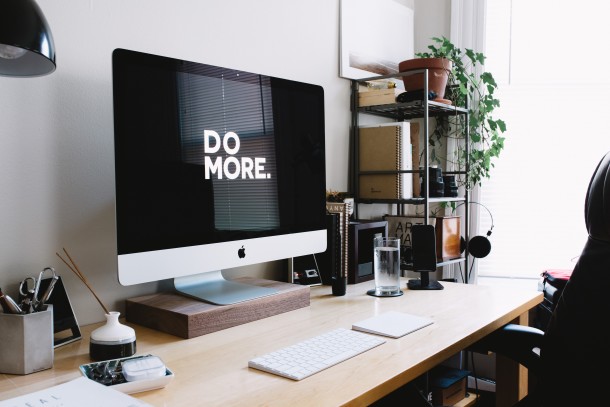My friends who work from home and have children, certainly have their hands full. They’re expected to ferry their little ones to school, rush back for some screen time with their co-workers, finish that report in double-time while the pasta boils over on the stove, “hop” on a 3-hour call with a client, and hurriedly churn out some data (it’s overdue) before shoving the last Dr. Oetker frozen pizza into the oven just as the other half arrives home with the tots.
And for those parents whose youngsters are home for “e-learning”? It’s probably easier to strike Toto than get through a video conference disturbance-free. Even for folks with pets, the charm of hearing your colleagues coo whenever your cat appears on camera soon wears off — pray tell, why must Whiskers always sleep on the keyboard when you’re using it???
Here are some ways to turn your apartment into the perfect work-from-home (WFH) office that inspires maximum productivity:
Sit near a window for natural light
Find a window seat that’s away from direct sunlight to reduce glare, yet provides some daylight. Studies have shown that natural light can promote learning, productivity, improve your mood, reduce stress, creativity, and physical well-being.
No wonder the top brass of your company usually get first dibs on offices with generous windows and ample natural light (not to mention a view).
Likewise, you should treat yourself like a CEO at home.
Introduce plants into your WFH space
Just like daylight, another natural element you should welcome into your new WFH space is the underrated houseplant.
Though some are really nothing to look at (just a collection of leaves to the uninitiated), they can aid in purifying the air, boosting the oxygen levels in your home, and brightening up your space while you struggle through a dull report.
Most of them are inexpensive, small and come ready-potted. So even if your newly-acquired lush landscape of 10 money plants don’t seem to inspire your sales, you can always shift a few of them to the balcony.
Fresh air is your friend
Seriously, there’s research to back up the fact that a poorly-ventilated space can decrease productivity levels, and with that, your health. On the other hand, a well-ventilated space can improve cognitive levels and promote well-being.
There’s also this actual thing called “sick building syndrome” — and it’s not about co-workers coughing their lungs out — it’s about feeling unwell but not sick when you’re in a building, and significantly better when you’re out. Root causes are usually mould, and chemical contaminants from office machines, paint or even dry markers, and of course, poor ventilation.
That headache you get every day without fail at 4pm? It could be more than your psychological allergic response to work.
Wherever possible, open your windows, ventilate your home, and turn on the fan!
Plan your day
Formal work events like meetings aside, make sure to plan your day in advance — yes, even your lunch breaks. For the workaholics, it will prompt you to tear your eyes away from the screen; for the easily distracted, it will help to refocus your mind, introduce discipline and structure your day for better productivity.
If your team is not already on apps like Asana, Trello, Clockify and Xero, try planning your day on Google Calendar. For example, I input my planned day’s tasks in coloured blocks on Google Calendar — important ones upfront, so I can get them out of my system before I reach mental fatigue — and make time for lunch (this could include errands), with a hard stop at a certain time.
How this can help you stay on track: Especially for that food-coma period after lunch, or momentary brain fog, seeing the tasks lined up on your calendar can jolt your memory — chase for this report today, submit the project by 5pm, remember to call John by 2pm to ask about the invoice, etc.
Invest in ergonomic furniture
If you’re going to be sitting there working 8 hours a day, 5 days a week, you need to be comfortable — and I’m not talking about slouching on the sofa, hunched over your laptop, or lying on your bed and typing propped up on one arm.
There’s a good visual diagram of how best to sit in front of your computer via Mayo Clinic. However, if you aren’t able to run out of the house to get everything in place… you can still make do with what you already have, even though it’s not ideal, such as how to best sit on your bed (you need adequate back support, like a lumbar cushion, with extra pillows to prop up your arms).
You might also want to try a standing desk, which in times of need, can be improvised from a small tray table and/or a box. Better still, you could even stand at your bar table. Besides, since it’s so cheap to improvise instead of investing in a $500 contraption, you can always return to your usual sitting desk if you don’t like it.
As always, no matter how purportedly good your position is, your body is meant to move. Take regular 5-minute breaks, walk around the house, do some stretching, and rest your eyes by looking at something far away every 45 minutes. Set a timer if you need to.
Create boundaries
One challenge of those who often work from home, is that they often end up working too much, and cannot differentiate work from play. This is because they don’t “travel home” to and from a physical office.
It’s important to create boundaries. For example, work remains in the study, but once you’re out, it’s time for a meal, for Netflix, for time with Junior; and the bedroom should always be a place for rest (unless you’ve got no choice).
Labelling a door clearly and teaching your kids not to disturb you when the door is closed can also be one strategy, or moving up your child’s bedtime to 7pm so you can get more work in if you are a night owl (just remember to schedule adequate breaks within your day).
If you have supportive neighbours, see if you can drop off your child at their place (do return the favour next time) if you need to tackle a high-focus task or attend to a super-important client call.
Sometimes the home can be too noisy, even with the doors closed. Sigh, thin walls. If you have good noise-cancelling earphones and a directional mic, you might be able to cancel out that siblings quibble in the living room.
If all else fails to make you more productive when you WFH, well, maybe you’re more suited to being in a regimented workplace, away from all the distractions of your home.
For more property news, content and resources, check out PropertyGuru’s guides section.
Looking for a new home? Head to PropertyGuru to browse the top properties for sale in Singapore.
Need help financing your latest property purchase? Let the mortgage experts at PropertyGuru Finance help you find the best deals.
This article was written by Mary Wu, who hopes to share what she’s learnt from her home-buying and renovation journey with PropertyGuru readers. When she’s not writing, she’s usually baking up a storm or checking out a new cafe in town.
Disclaimer: The information is provided for general information only. PropertyGuru Pte Ltd makes no representations or warranties in relation to the information, including but not limited to any representation or warranty as to the fitness for any particular purpose of the information to the fullest extent permitted by law. While every effort has been made to ensure that the information provided in this article is accurate, reliable, and complete as of the time of writing, the information provided in this article should not be relied upon to make any financial, investment, real estate or legal decisions. Additionally, the information should not substitute advice from a trained professional who can take into account your personal facts and circumstances, and we accept no liability if you use the information to form decisions.









